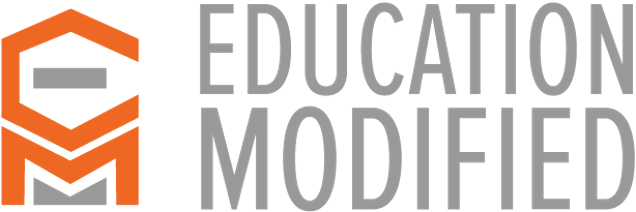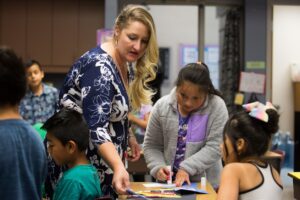SUPPORTING SPECIAL EDUCATION THROUGH CO-TEACHING
This summer has recently been called ‘a time of reckoning’ by education experts, policy-makers and district leaders who are thinking ahead to a few short weeks before the 2022- 2023 school year. The shortage of teaching staff, especially special education teaching staff, is calling for a review of staffing practices to reconsider the traditional model of one classroom, one teacher. We need ‘all hands on deck’ and many staff members in one classroom. This might sound counterintuitive to a problem that just highlighted less teachers and not more, but hear me out:
Before being the founder of Education Modified, I was the first co-teacher at a large high school in New York City. As a special education teacher, I co-taught in hundreds of different classrooms over 9 years with general education content specialists: grades 8- 12 English language arts, history, social studies, science, and social science classes. While I also taught self-contained and resource room pull-out classes, the majority of my teaching career was in a classroom with another teacher. At a minimum of 10 classes a week, if not sometimes 15, 20, or even 30 classes a week, it was my job to modify the curriculum and support 5-10 students with disabilities in general education classes of 30+ students. This also by default included students with other needs, such as English Language learners, or students without a formal diagnosis.
What does this have to do with anything happening now? Well at the Council of Administrators of Special Education’s Special Education Legislative Summit a few weeks ago at the country’s capitol, leaders, policymakers and educators listened as various experts and leaders spoke in a very somber tone regarding the topic of special educator staffing shortages.
We unfortunately have reached an unprecedented time in education where we have the most staffing shortages in education than we have ever seen. “All hands on deck”, “It takes a village”, or “All for one and one for all”- whichever saying you choose, there has never been a more applicable time for special education than now.
What we know is that there aren’t enough special educators or paraprofessionals to serve students with special needs.
Many solutions have been discussed: More funding at federal, state and local levels to offer competitive pay for special educators as well specialized instructional support personnel, like speech therapists and others”, as well as new, more and improved programs for recruitment and retention of educators. Additionally, new policies that allow the transfer of teaching credentials from state-to-state, and new, improved quality PD for special education Another potential solution was turning to substitutes as stop gaps. A fantastic article in EdWeek challenging the traditional one teacher, one classroom model, highlights two new, innovative staffing approaches to our staff coming in the door this Fall.
These suggested models coming out of Mary Lou Fulton Teachers College at Arizona State are promising, exciting, and exactly the direction we need to go in terms of a workforce of educators in this new post-pandemic world. Research shows that students perform better when their teachers are more collaborative, and so it makes sense that teams of teachers can better support students.
Additionally, as a teacher, I was the product of another exciting approach: a specific mentor & coach. Mine was given to me for my first two years teaching, she was my coach as well as three other special educators, and was also the literacy specialist at the school. This research-based solution designed by Public Impact Opportunity, Culture, has seen great success in over 55 school systems since it launched in 2013.
My team and I, as special education domain experts, would like to take that one step further to specifically empower general education teams, curriculum teams, and teaching and learning teams to join this new era of flexible, collaborative approach to support students with disabilities: Co-teaching with general educators.
Just like many of the solutions mentioned above, this idea is not new. There have been previous movements to break down silos using co-teaching that were seen particularly in urban education settings, fueled by the huge influx of teachers from programs like Teach for America and the Urban Teacher Residency in the early 2000’s. I entered the profession in 2005 and co-teaching was something I was asked to do. I assumed this happened everywhere.
Co-teaching is a research-based approach to breaking down silos between general educators and special education students. Anyone reading this with experience in special education has heard of the 6 models of co-teaching. I entered a classroom in the 2005- 2006 school year as a special education co-teacher and worked with 2-3 general ed teachers each day. I supported students and the general education teacher at the same time. But what hasn’t been discussed is: How do we do that? How do we facilitate the informing, including and empowering of general education teachers to support students with disabilities and make co-teaching a standard practice?
Dr. Keith Neis, the Supervisor of Special Education in Fairview School District believes the first step is a common language when speaking about kids. He stated, “To give our students with disabilities the best chance to succeed and feel included, we must get past the notion that these students are only the responsibility of the special education teacher. I often used to hear, that is “your student”, when really we should be saying, that is “our student”.
The second is common participation. “We also include and expect all of our general educators to participate in IEP team meetings. We give them a voice and allow them to discuss and share information relating to those students with disabilities that participate in their classroom.” For the schools in Fairview that are co-teaching, the district also empowers general ed teachers with a choice to participate in inclusive classrooms. “We give general ed teachers the ability to opt-in to co-teaching, and it has been extremely powerful.”
Kim Hart-Kindelberger, a special education teacher in West Hartford Public Schools in CT has implemented technologies, such as Education Modified, that can empower general educators, allowing them to feel confident and capable of providing the support necessary to serve students effectively. Technology such as this can automatically create lists of students requiring accommodations, modifications & support, this way general education teachers have a quick and easy way to access information they need, when they need it.
For Clarkson Public Schools, a small district in Nebraska with very a high percentage of special education students for a district their size, “it is just the norm for us to have all general and special ed teachers work with all students. We have been very mindful of identifying kids early and do push-in instead of pull-out, especially in middle school. This helps a lot with reducing the stigma,” says Lee Schneider, the 7-12 Principal. The district has also implemented ‘WIN time’, the intervention block they created to support their robust MTSS process, for all students- whether it is enrichment or intervention. This “What I Need” approach has allowed all teachers to provide specific support to different students, while empowering all general education teachers to provide Tier 1 and Tier 2 instruction.
As mentioned, now is the time that school and district leaders can make a commitment to the strategic initiative that includes and empowers general education teachers to help with the current crisis. Whether it is using creative staffing solutions to have one special educator co-teach 3 different classes, or if you simply set an exceptionality of common language at the beginning of this school year, you must acknowledge that it can no longer be ‘my students’ or ‘your students’.
They are literally our students, especially if no one else is there to teach them.





